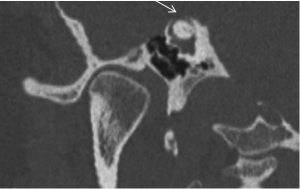Dehiscence of the superior canal
Dehiscence of the superior canal is a defect in the bone covering the labyrinth and more specifically at the level of the superior semicircular canal. This produces what is called a “third window”. With the effect of the third window, the patient develops cochlear and vestibular symptoms.
Patients suffer from hyperacusis. They are disturbed by loud sounds and does not tolerate any noise. They have an autophonia: they hear the sound of their steps, the movements of their eyes and it resonates every time they speak. They hear their own breathing and heartbeat.
They also complain of dizziness and imbalance. This increases with exposure to noise (Tullio’s phenomenon), walking and physical effort. But also complain of permanent instability, or difficulty to fix the objects when the body is in motion (oscillopsia).
The ENT request an audiogram, a VEMP, a VNG, a high-resolution CT scan of the mastoid with fine cuts and a special reformatting of the images in the plane of the superior semicircular canal in order to highlight the dehiscence and confirm the diagnosis.
In cases where the patient is symptomatic and does not tolerate symptoms, surgery may be performed to obliterate dehiscence (the tip of the arrow in the figure below).

_____________________________________
Anatomy and Function of the labyrinthe
Definition
Do you have vertigo? An imbalance?
Benin Paroxysmal Positional Vertigo (BPPV)
Meniere’s disease
Neuronitis or vestibular neuritis
Labyrinthitis
Dehiscence of the superior canal
Cervical dizziness
Perilymphatic fistula
Migraine and vertigo / Vestibular Migraine
Basilar migraine and vertigo
Vertigo of central origin
Psychogenic vertigo
Vertebrobasilar insufficiency and imbalance
